ppt
advertisement
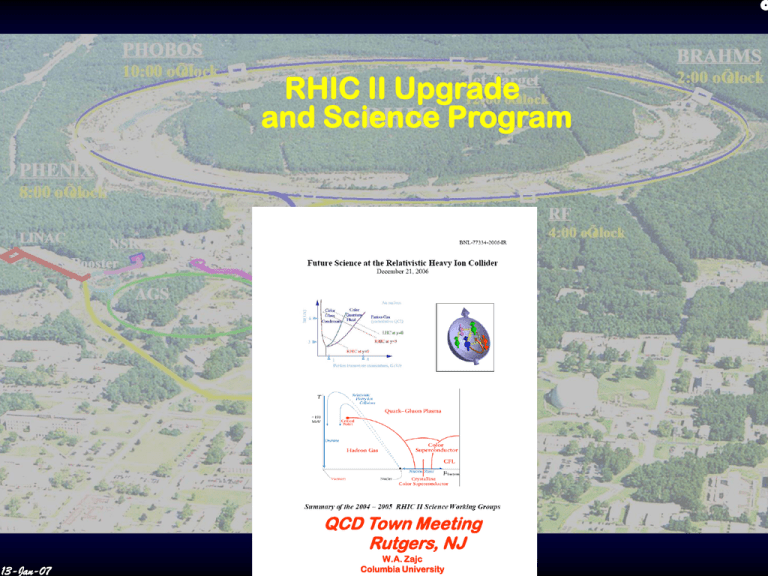
RHIC II Upgrade and Science Program QCD Town Meeting Rutgers, NJ 13-Jan-07 W.A. Zajc Columbia University Outline A capsule history of the initial discovery phase of RHIC operations Compelling scientific questions for RHIC II The elements of RHIC II The primacy of QCD 13-Jan-07 The Plan c. 2000 Use RHIC’s unprecedented capabilities Large √s Access to reliable pQCD probes Clear separation of valence baryon number and glue Polarized p+p collisions Two small detectors, two large detectors Complementary capabilities Small detectors envisioned to have 3-5 year lifetime Large detectors ~ facilities Major capital investments Longer lifetimes Potential for upgrades in response to discoveries 13-Jan-07 Since Then… Accelerator complex Routine operation at 2-4 x design luminosity (Au+Au) Extraordinary variety of operational modes Species: Au+Au, d+Au, Cu+Cu, p+p Energies: 22 GeV (Au+Au, Cu+Cu, p), 56 GeV (Au+Au), 62 GeV (Au+Au,Cu+Cu, p+p) , 130 GeV (Au+Au), 200 GeV (Au+Au, Cu+Cu, d+Au, p+p), 410 GeV (p), 500 GeV (p) Experiments Science Worked Collaborations worked 160 refereed publications, 89(!) PRL’s Major discoveries Future 13-Jan-07 Demonstrated ability to upgrade Key science questions identified Accelerator and experimental upgrade program developed to perform that science A Non-Surprise: RHIC Energy Reduces Scale Dependence The high √s of RHIC makes contact with rigorous pQCD calculations minimizes “scale dependence” Spin program Providing calibrated probes in A+A A huge advantage in PHENIX p+p p0 + X -NLO pQCD F. Aversa et al. Nucl. Phys. B327, 105 (1989) -CTEQ5M pdf/PKK frag -Scales m=pT/2, pT, 2pT m=pT/2 m=2pT 13-Jan-07 RHIC Spin Successes Absolute Polarimeter (H jet) RHIC pC Polarimeters BRAHMS & PP2PP (p) Lmax 2 1032 s 1cm 2 Achieved 60-65% polarization during RHIC Run-6 ! 70% Polarizati on 50 s 500 GeV PHENIX (p) STAR (p) Siberian Snakes Spin Rotators Partial Siberian Snake LINAC BOOSTER Pol. Proton Source 500 mA, 300 ms 2 1011 Pol. Protons / Bunch e = 20 p mm mrad AGS 200 MeV Polarimeter AGS Internal Polarimeter Rf Dipoles RHIC accelerates heavy ions to 100 GeV/A and polarized protons to 250 GeV 13-Jan-07 Our First Hard Look “Standard” value of Dg from pre-RHIC DIS data Δg(x) g (x) - g - (x) Assuming Dg = 0 13-Jan-07 Discovery of strong “elliptic” flow: Elliptic flow in Au + Au collisions at √sNN= 130 GeV, STAR Collaboration, (K.H. Ackermann et al.). Phys.Rev.Lett.86:402-407,2001 307 citations Discovery of “jet quenching” Suppression of hadrons with large transverse momentum in central Au+Au collisions at √sNN = 130 GeV, PHENIX Collaboration (K. Adcox et al.), Phys.Rev.Lett.88:022301,2002 357 citations 13-Jan-07 Suppresion Factor Flow strength RHIC’s Two Major Discoveries To Summarize The hottest T ~ 200- 400 MeV densest ei ~ 30-60 eo matter (thermal yields) ever studied in the laboratory flows large “elliptic” flow as a (nearly) perfect fluid with systematic patterns consistent with quark degrees of freedom valence quark scaling and a viscosity to entropy density ratio lower (?) than any other known fluid with a value near (?) a conjectured quantum bound 13-Jan-07 h/s ~ (2-3) /4p See aS Run The low viscosity is “understood” as a result of Short mfp’s Large cross sections Strong coupling near the phase “transition” (really cross-over) Small h/s sQGP Strongly-coupled Quark-Gluon “Plasma” “Perfect liquid" We need to understand as when it is large! “The strong coupling constant at low Q2”, A. Deur, hep-ph/0509188 “Perturbative QCD theory (includes our knowledge of as )”, Y. Dokshitzer, hep-ph/9812252 13-Jan-07 How Perfect is “Perfect” ? All “realistic” hydrodynamic calculations for RHIC fluids to date have assumed zero viscosity Viscosity h = 0 “perfect fluid” But there is a (conjectured) quantum limit: “A Viscosity Bound Conjecture”, P. Kovtun, D.T. Son, A.O. Starinets, hep-th/0405231 h ( Entropy Density ) s 4p 4p Where do “ordinary” fluids sit wrt this limit? RHIC “fluid” might be at ~2-3 on this scale (!) 4p 13-Jan-07 T=1012 K RHIC Future The fundamental matter created at RHIC compels further investigation How imperfect is its “perfection” ? How does it respond to truly heavy probes? (charm, bottom) Can even higher energy densities be achieved in U+U collisions? Is there a critical point in the QCD phase diagram ? All of this (and more) is addressed by RHIC II: EBIS Electron Beam Ion Source to extend ranges of species Upgrades to STAR and PHENIX Vertex detectors for precision heavy flavor tomography Increased coverage in forward regions Increased rate and triggering capabilities x10 Luminosity increase by electron cooling Efficient access to the rare probes that have proven so incisive in the first generation discovery measurements at RHIC. 13-Jan-07 RHIC II Luminosity Enhancement via e-Cooling Gold collisions (100 GeV/n x 100 GeV/n): Ave. store luminosity [1026 cm-2 s-1] Pol. Proton Collision (250 GeV x 250 GeV): Ave. store luminosity [1032 cm-2 s-1] 13-Jan-07 no e-cooling 8 1.5 with e-cooling 70 5.0 Ongoing experiments and simulations in progress Detector Upgrades Ongoing effort with projects in different stages PHENIX STAR forward meson spectrometer DAQ & TPC electronics Key: full ToF barrel Completed heavy flavor tracker ongoing barrel silicon tracker proposal submitted forward tracker proposal in preparation 13-Jan-07 hadron blind detector muon Trigger silicon vertex barrel (VTX) forward silicon forward EM calorimeter Fundamental Questions for RHIC II What are the phases of QCD Matter? What is the wave-function of a heavy nucleus? What is the wave-function of the proton? 13-Jan-07 What is the nature of non-equilibrium processes in a fundamental theory? Compelling Physics of RHIC II Provide key measurements so far inaccessible at RHIC in three broad areas: High T QCD (A+A, d+A, and p+p): Spin structure of the nucleon: Electromagnetic radiation (e+e pair continuum) Heavy flavor (c- and b-production) requires highest Jet tomography (jet-jet and g-jet) AA luminosity Quarkonium ( J/, ’ , c and (1s),(2s),(3s) ) Quark spin structure Dq/q (W-production) Gluon spin structure Dg/g (heavy flavor and g-jet correlations) Low x phenomena “Low x” “forward measurements” gluon saturation in nuclei (particle production at forward rapidity) All measurements require upgrades of detectors and/or RHIC luminosity 13-Jan-07 What is the wave-function of the proton? 13-Jan-07 Spin Goals for RHIC II Use the increased luminosity to achieve a precision in Dg comparable to (at least) present knowledge of DS : ΔΣ Δq(x)dx 0.1 0.3 q 1 3nf 0.18 2 3nf 16 1 DS Lq Dg Lg 2 } } 1 2 proton 0.32 1 16 2 3nf 16 Asymptotic expectation ( X. Ji, J. Tang, P. Hoodbhoy, Phys.Rev.Lett. 76, 740 (1996) ) Cleanest probe for Dg(x) : Prompt-photon production ( g-jet, to determine parton kinematics ) Also the rarest, clearly benefits from increased luminosity RHIC II samples of ~ 1 fb -1 allow 13-Jan-07 Systematic cross checks (e.g., same x measured at variety of Q2 ) Extension to small x regions (using forward upgrades) Spin Goals for RHIC II (Cont’d) Sea quark/antiquark polarization Flavor decomposition likely to be key to understanding small value of DS . Major tool: Parity-violating single-spin asymmetry AL from W ± decays. Requires ~ 1 fb-1 data sets RHIC II luminosity Detector upgrades Ultimate goal: charm-tagged W’s Transverse spin measurements 13-Jan-07 To study transversity To understand role of quark angular momentum To extract Sivers functions over unparalled range of x and Q2 . What is the wave-function of a heavy nucleus? 13-Jan-07 A Surprise: RHIC Multiplicities Are “Low” PHOBOS Central Au+Au (200 GeV) Low, that is, compared to pre-data predictions of “cascading partons” Consistent with predictions based on gluon saturation : Kharzeev & Levin, Phys. Lett. B523 (2001) 79 Compilation by K. Eskola Color Glass 600 From Eskola, QM 2000 13-Jan-07 1200 Rapidity Density Data: PHOBOS, Phys. Rev. Lett. 87, 102303 (2001) Assertion In these complicated events, we have (a posteriori ) control over the event geometry: Degree of overlap Number of (nucleon) participants NPart “Central” 13-Jan-07 Orientation with respect to overlap “Peripheral” Saturation Running of aS dN/dh / .5Npart 23 2 QS NCH 1 ~ ~ log( ) ~ log(NPart ) 2 2 NPart αS (Q S ) Λ NPart Fundamental Fields in Nuclei Nucleus increases saturation momentum scale QS 2 ~ (A/x)1/3 Occupation numbers ~ 1 / aS(QS) > 1 This is the condition for ~ classical fields: That is: Quasi-classical states of the gluon field may be explored at low x in a nucleus Exploration tools: Near-term: d+A collisions (RHIC RHIC II) Long-term: Electron-ion Collider Goal: 13-Jan-07 To understand the wave-function of a heavy nucleus Relevance to Heavy Ion Collisions Lesson from RHIC: A+A collisions are very efficient in translating Initial gluon state Strong shadowing? Saturated gluons? Color Glass Condensate? into Final thermal state It is difficult to understand this efficiency without invoking some form of dense gluonic initial state We need to measure rather than invoke 13-Jan-07 What are the phases of QCD Matter? What is the nature of non-equilibrium processes in a fundamental theory? 13-Jan-07 Understanding the Medium Energy loss in a fluid: ☑ Jets travel faster than the speed of sound in the medium. ☑ While depositing energy via interactions with same QCD “sonic boom” or “Mach cone” To be expected in a dense fluid which is strongly-coupled 13-Jan-07 Observation of Mach Cone? Seen in di-hadron correlation functions in Df : Modifications to di-jet hadron pair correlations in Au+Au collisions at √sNN = 200 GeV, (S.S. Adler et al.), Phys.Rev.Lett.97:052301,2006 Df Sensitive to Df 13-Jan-07 Speed of sound Equation of state The Ultimate Calibrated Probe Extend the di-hadron correlations to (direct) photon-hadron correlations Photons emerge directly, unaffected by the medium A clean measure of initial (hard) Q2 Heavy ion analog to tagged photon beam Current state of the art: g-h h-h as compared to A potentially beautiful technique, desperately in need of RHIC II luminosities ! 13-Jan-07 Heavy Flavor at RHIC II Because the u, d, (s) current masses are small compared to T Properties of the medium are (at zero baryon number) uniquely determined by T But “introducing” heavy flavor establishes a new scale: Mc ~ 1.3 GeV Mb ~ 5.0 GeV with associated length scales 1 / Mc ~ 0.15 fm 1 / Mb ~ 0.04 fm Flavor tagged jets to measure Mach cones, heavy quark energy loss Flow strength Bohr radii (onium): J/Y ~ 0.29 fm U ~ 0.13 fm “Onium” spectroscopy RHIC to measure plasma screening lengths Measurements of such essential medium properties using rare probes becomes possible via RHIC II luminosities and the detector upgrades 13-Jan-07 The Promise of Heavy Flavor Present measurements rely on detection of e’s, m’s from semi-leptonic decay of heavy flavor Little or no ability to determine relative contributions of charm versus bottom But recent results for Energy loss: RAA(pT) Flow : v2 (pT) Strongly suggest h s ~ (2 3) 4p “Energy Loss and Flow of Heavy Quarks in Au+Au Collisions at √sNN = 200 GeV”, A. Adare et al., submitted to PRL, nucl-ex/0611018 Similar estimates obtained from Light quark flow PT fluctuations 13-Jan-07 “What do elliptic flow measurements tell us about the matter created in the little bang at RHIC?”, R. Lacey and A. Taranenko, nucl-ex/0610029 “Measuring Shear Viscosity Using Transverse Momentum Correlations in Relativistic Nuclear Collisions”, S. Gavin and M. Abdel-Aziz, nucl-th/0606061 Water RHIC Water RHIC h/s The search for QCD phase transition of course was informed by analogy to ordinary matter Results from RHIC are now “flowing” back to ordinary matter “On the Strongly-Interacting Low-Viscosity Matter Created in Relativistic Nuclear Collisions”, L.P. Csernai, J.I. Kapusta and L.D. McLerran, Phys.Rev.Lett.97:152303,2006, nucl-th/0604032 13-Jan-07 Is There a QCD Critical Point? Here the analogy with phase transitions in ordinary matter breaks down: Recall “ Properties of the medium are (at zero baryon number) uniquely determined by T ” Pressure = P(T) can’t vary independently (unlike water) But if baryon number is non-zero (intensive order parameter) baryon chemical potential mB : To increase mB : Lower collision energy Raise atomic mass Both part of RHIC II 13-Jan-07 EBIS Status EBIS Electron Beam Ion Source Replaces tandems (thereby avoiding ~$9 M reliability investment) Extends range of species (polarized 3He, noble elements, uranium ) Approved for construction CD-1 obtained $19.4M cost ($4.5M NASA) 3.5 yr schedule FY06-09 New Physics! (Next slide) 13-Jan-07 U+U collisions 13-Jan-07 Static deformation provides a way to vary the ‘other’ order parameter (baryon chemical potential mB ) RHIC’s Energy Range Ideal For The Hunt There is considerable uncertainty in the location of the QCD critical point RHIC RHIC II can make major advances on the “other” QCD front: U+U beams Comprehensive detectors Collider superb control of systematics when changing √s Major importance when varying √sNN from 5 to 200 GeV ! RHIC II will be the ideal facility for systematically exploring the major region of the QCD phase diagram. 13-Jan-07 Heavy Ions at the LHC How could we not choose to investigate “QGP” at every opportunity? LHC offers unparalleled increase in √s Will this too create a strongly-coupled fluid? Active pursuit via 13-Jan-07 Dedicated experiment (ALICE) Targeted studies (CMS, ATLAS) RHIC II and LHC Heavy ion collisions at the LHC could reveal entirely new phenomena. With RHIC II and LHC together we explore deconfined QCD matter over an unprecedented range … With RHIC II e-cooling, log 1/x the integrated luminosity per year is 36x larger at RHIC than LHC for heavy ions. From yesterday (Urs Wiedemann): from “The properties of the hot and dense QCD matter produced at the LHC may differ those produced at RHIC. We can state already now that testing QCD evolution of properties of hot and dense QCD matter is of fundamental interest and is experimentally testable in an interplay of RHIC and LHC… Knowledge about (rare hard high-pT) probes at RHIC can be improved significantly with a luminosity upgrade, which thus could enhance the interplay between RHIC and LHC significantly (in particular if operational during the LHC discovery era).” RHIC II will continue the demonstrated RHIC capabilities 13-Jan-07 Precision probes Extended data runs Wide variety of beams and energies. From Urs Wiedemann (yesterday) 1. Results from the LHC heavy ion run will provide substantial novel tests for the key dynamical ideas (hydrodynamic behavior, hard parton propagation in matter, saturation) developed in the context of the RHIC heavy ion program. Consequence: 2. The properties of the hot and dense QCD matter produced at the LHC may differ from those produced at RHIC. We can state already now that testing QCD evolution of properties of hot and dense QCD matter is of fundamental interest and is experimentally testable in an interplay of RHIC and LHC. Consequence: 13-Jan-07 Any theory initiative (even if it aims primarily at meeting the challenges of the RHIC heavy ion program), must aim at an unbiased use of all experimental constraints. The most successful theory efforts will work towards a phenomenological framework testable in the entire energy range spanning RHIC and LHC. We should recognize this novel opportunity. Rare hard high-pt probes provide the most versatile class of tools for characterizing properties of matter. Knowledge about these probes at RHIC can be improved significantly with a luminosity upgrade, which thus could enhance the interplay between RHIC and LHC significantly (in particular if operational during the LHC discovery era). Long Term Timeline of Heavy Ion Facilities 2009 2006 2012 2015 QCD Laboratory at BNL RHIC Vertex tracking, large acceptance, rate capabilities PHENIX & STAR upgrades electron cooling “RHIC II” electron injector/ring “e RHIC” LHC FAIR Phase III: Heavy ion physics 13-Jan-07 RHIC and RHIC II in World Context : 2009 : 2000RHIC II : 2012 13-Jan-07 New Dimensions Expanding our theoretical tools Perturbative QCD (pQCD) for understanding jet quenching Lattice QCD (LQCD) for calculating static properties (s, e) Hydrodynamics as zero-mean-free-path limit of strong coupling AdS/CFT for calculating static and dynamic properties of strongly-coupled gauge theories Both sides of this equation ( Vis cosity )R H IC ( Entropy Density )R H IC 4p were calculated using black hole physics (in 5 dimensions) MULTIPLICITY Entropy Black Hole Area c c DISSIPATION Viscosity Graviton Color Screening 13-Jan-07 Absorption New Dimensions in RHIC Physics “The stress tensor of a quark moving through N=4 thermal plasma”, J.J. Friess et al., hep-th/0607022 Our 4-d world String theorist’s 5-d world 13-Jan-07 The stuff formerly known as QGP Jet modifications from wake field Heavy quark moving through the Energy loss medium from string drag SGP “Formerly known as quark-gluon plasma?” You can still use that label if you like, but- PARADIGM SHIFT RIHC does not produce asymptotically “free” quarks and gluons Contrary to expectations (and announcements ! ), we did not find evidence for “quarks (that) are liberated to roam freely” The analogy to atomic plasmas is also strained: Atomic plasmas: Can vary density and temperature independently Photon momentum-energy density (usually) irrelevant Can be strongly-coupled or weakly coupled “QGP” One number (the temperature T ) determines all properties Intrinsically strongly-coupled fluid for any(?) accessible T The matter created at RHIC could be called “S G P” 13-Jan-07 S G P Sui Generis Plasma Sui generis : “Being the only example of its kind; unique ” The Primacy of QCD While the (conjectured) bound h s 4p is a purely quantum mechanical result . . . It was derived in and motivated by the Anti-de Sitter space / Conformal Field Theory correspondence Weak form: “Four-dimensional N=4 supersymmetric SU(Nc) gauge theory is equivalent to IIB string theory with AdS5 x S5 boundary conditions.” ( The Large N limit of superconformal field theories and supergravity, J. Maldacena, Adv. Theor. Math. Phys. 2, 231, 1998 hep-th/9711200 ) Strong form: “Hidden within every non-Abelian gauge theory, even within the weak and strong nuclear interactions, is a theory of quantum gravity.” ( Gauge/gravity duality, G.T. Horowitz and J. Polchinski, gr-qc/0602037 ) Strongest form: Only with QCD can we explore experimentally these fascinating connections over the full range of the coupling constant to study QGP Quantum Gauge Phluid 13-Jan-07 RHIC Scientific Future Fundamental Strings(??) Fundamental Particles Understand the spin structure of the nucleon p+p at RHIC, RHIC II, …. Polarized e-p collider Fundamental Fields Understand the wave-function of a heavy nucleus d+A at RHIC, RHIC II, …. Electron-ion collider Fundamental Matter Understand the phase diagram of QCD A+A at RHIC, RHIC-II, LHC, FAIR 13-Jan-07
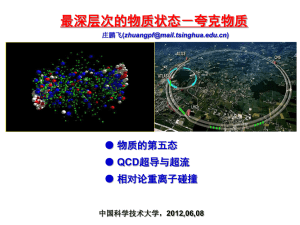
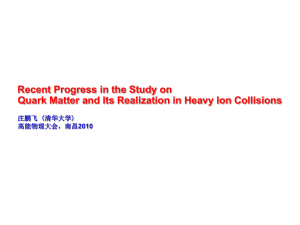
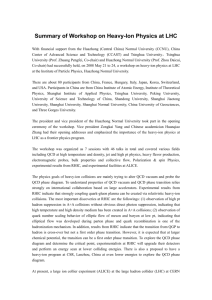
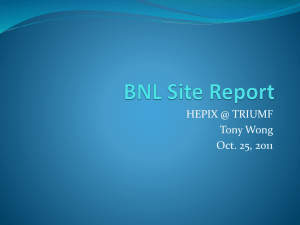
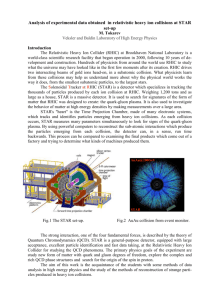
![Lecture 3 [pptx] - Triangle Universities Nuclear Laboratory](http://s2.studylib.net/store/data/005775243_1-37c3b33c412a7530285b46f51206c4ad-300x300.png)